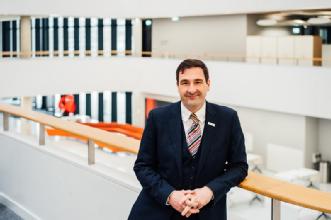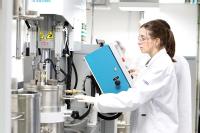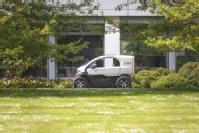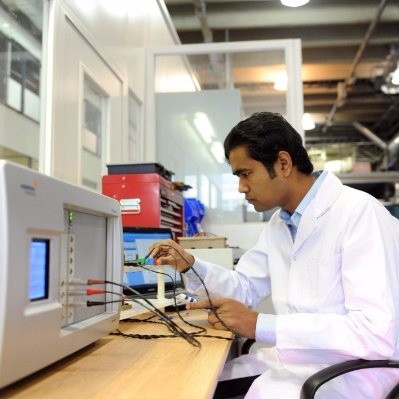WMG News - Latest news from WMG
Expert comment from Professor David Greenwood
WMG is delighted at the news that Britishvolt have been purchased by Recharge.
Professor David Greenwood, Director of Industrial Engagement at WMG, University of Warwick said: “This is great news for the UK, allowing us to capitalise on the value realised under the previous ownership. High value jobs will be protected and created in the UK as a result of this purchase - not just in the company, but in its upstream and downstream supply chains.
“For the UK to remain globally competitive, it is critical that we establish a strong battery manufacturing base to support many of our key industrial sectors, including automotive, aerospace, rail, marine and energy storage.”
WMG looks forward to continuing to support the growth of the UK battery industry.
Read more about the news here: https://www.bbc.co.uk/news/business-64754879
UK Government awards £9.5m to British consortium to build world first advanced electric flight ecosystem
- New consortium of leading British aviation companies awarded government funding to demonstrate the commercial and operational viability of Advanced Air Mobility (AAM)
- First-of-a-kind ecosystem will accelerate introduction of AAM in the UK
- Demonstration of urban and cross-country flights planned at London Heathrow, Bristol, London City airports and a new vertiport at a London General Aviation (GA) airport
Vertical Aerospace, Virgin Atlantic, Atkins, Skyports and NATS, along with Connected Places Catapult and leading academic institutions Cranfield University and WMG, University of Warwick, today announced the creation of the Advanced Mobility Ecosystem Consortium. Together, the organisations will develop key technology and infrastructure in a project that will significantly accelerate the introduction of AAM in the UK.
The Consortium has been awarded a £9.5 million grant by the UK Government’s Future Flight Challenge to develop the essential building blocks of a viable AAM ecosystem that has the potential to be progressed into full commercial operations. This first-of-a-kind ecosystem will accelerate AAM in the UK by creating and testing technological developments in aircraft electrification, airspace management, ground infrastructure, operational procedures and the systems and supporting business cases required to implement a new model of aerial passenger transport in the UK.
Accelerating AAM
The project will demonstrate the feasibility of a UK AAM ecosystem using Vertical Aerospace’s emission-free VX4 eVTOL aircraft, operated by Virgin Atlantic. Two physical flights will take place between Bristol Airport to an airfield in South West England, and between London Heathrow Airport and the Living Lab vertiport. A third simulation flight will demonstrate urban connectivity between London City and Bristol airports.
These demonstrations will explore key aspects of the passenger journey, vehicle operation, airspace navigation, ground charging, security provision and local stakeholder engagement. Heathrow Airport, Bristol Airport, Skyports and NATS, the UK’s national air navigation service provider, will collaborate to deliver the physical and digital infrastructure to facilitate these missions through a complex airspace environment. The two-year project will be overseen by aerospace engineering experts Atkins as consortium lead.
Benefits of Advanced Air Mobility
AAM offers a new form of travel, enabling cost-effective connectivity into congested urban areas and across regions under-served by existing infrastructure. The UK Government Future Flight Challenge forecast that the introduction of AAM services will increase UK GDP by 1.8% by 2030 and support the government’s Levelling Up and Net Zero agendas, reflecting the productivity and wider economic benefits of increased connectivity.
James Richmond, Head of Advanced Air Mobility at Atkins, said: “This is an exciting leap forward for AAM. This project brings together experts from across the industry to maintain the UK’s leading position in the future of aviation, moving us closer to commercial operations that will connect regions and contribute to the UK’s net zero targets.”
Professor David Greenwood, CEO of the High Value Manufacturing Catapult at WMG, added: This project, created by a major consortium of aviation leaders, will really push forward the boundaries of developing and proving commercial eVTOL flights by demonstrating in a real-time, operational AAM ecosystem testbed. WMG is delighted to be contributing to a project which will help the UK aviation industry meet its net zero carbon goals.”
Other nations are racing to establish their own AAM ecosystems by 2025 – this project ensures the UK will be amongst the leaders in this new decarbonised form of transport. Gary Cutts, Future Flight Challenge Director at UK Research and Innovation said: “our roadmap sets out how air taxis could be in use in the UK by 2030, but a lot needs to occur for that to happen. By bringing technical developments from across the aviation industry together into one network, and undertaking early demonstration in the real-world, the Advanced Mobility Ecosystem Consortium could accelerate the timescale for AAM introduction by years. This project could revolutionise travel, not just in the UK but around the world.”
Novel Infrastructure
Skyports will build and operate a “Living Lab” vertiport to create a testbed for ground, passenger and air operations for the project duration. This centre of innovation will help to materially accelerate the development of AAM services and establish the UK as a leader in the design and operation of vertiport infrastructure.
Duncan Walker, CEO of Skyports, said: “Just as airports are critical to commercial aeroplane travel, vertiports are critical to AAM. Our Living Lab will be a central component of the consortium, enabling Skyports and partners to demonstrate end-to-end operations and test the complexities of developing a commercially viable AAM network in the UK.”
New Regional Air Connectivity
Holly Boyd-Boland, VP Corporate Development at Virgin Atlantic, said: “We are thrilled to be working alongside our consortium partners to accelerate the introduction of zero emission flight to UK customers. As the only airline in the consortium, Virgin Atlantic brings 38 years of operational excellence, a relentless focus on safety and security, and an unrivalled focus on the end-to-end customer journey. Alongside our partners, we are looking forward to getting the first Virgin Atlantic eVTOL aircraft into the skies.”
Andrew Macmillan, Director of Strategy of Vertical Aerospace, said: “Vertical is not flying solo. We are building the best industrial and commercial partner ecosystems and are progressing in Britain with our UK launch customer, Virgin Atlantic. We want the UK to lead the electric aviation and AAM revolution. This consortium will help prove how we can deliver safer, cleaner and quieter air travel with the VX4.”
A focus on integration
Atkins will lead the consortium and is responsible for technical management and integration of the two-year programme as it moves AAM from concept stage towards implementation. It will leverage its decades of aviation expertise to oversee the systems architecture and deliver a digitally enabled passenger journey management tool for infrastructure and flight operators.
For further information on WMG's research in this area, visit: https://warwick.ac.uk/fac/sci/wmg/business/transportelec/
*The full Advanced Mobility Ecosystem Consortium comprises Atkins; Vertical Aerospace; Skyports; Virgin Atlantic; Heathrow Airport; London City Airport; Bristol Airport; NATS; Cranfield University; WMG, at the University of Warwick; Connected Places Catapult; with support from EVE Air Mobility.
Aerospace electrification: Accelerating the opportunity
 The Aerospace Electrification event with WMG and ATI successfully brought together thought leaders and experts from across the aerospace supply chain and other sectors.
The Aerospace Electrification event with WMG and ATI successfully brought together thought leaders and experts from across the aerospace supply chain and other sectors.
Such events are vital to understand the opportunities and challenges faced by the sector, and a collaborative approach combining industry and academia will help the UK to continue its place at the forefront of transport electrification.
A series of presentations, workshops and Q&A led to a lively critical analysis of the topics at hand for aerospace electrification. These included safety, energy storage, electric drives, power electronics, thermal management, whole-vehicle optimisation and many more.
Alison Meir, Head of Business Development, WMG HVM Catapult, chaired the event, and introduced our first speaker, Mark Scully, Head of Advanced Systems and Propulsion at the ATI, who set the scene. Aerospace electrification has been a topic for some time now and technology is developing apace, with propulsion systems, subsystems and ancillaries all being electrified. Mark highlighted huge opportunities for the sector, with funding from UK Government supporting collaborative R&D in electrification. The ATI welcomes enquiries from industrial, academic and other stakeholders looking for R&D support.
Battery technologies and associated key metrics were presented by David Rawlins, Chief Technology Officer (CTO) at WMG. The safety-conscious nature of the aerospace industry has typically led to a modest pace of development in such technologies compared with, say, automotive. David identified that aerospace engineers are trained to design for perfection, but with future architectures and technologies still fledgling, no one knows what the perfect or ‘right’ solution yet is. So, there is opportunity for faster paced R&D. There is a growing evidence base on the limitations of battery technology and the trade-offs of power density against energy density, primarily driven by the automotive sector. As such, it is vital that the sector remains committed to influencing and leading battery technology for aerospace. An example is the ATI ACCEL programme, involving Electroflight and Rolls Royce, in partnership with Yasa, WMG and more. The continual need to engage with and influence the regulatory bodies for safety and certification was a poignant discussion point.
Future hybrid and all-electric aircraft will use radically different architectures to the aircraft of today, enhancing the need for a holistic systems engineering approach to design and integration. Sarabpal Bhatia, E-Fan X R&T Coordination Manager at Airbus, provided insight into the considerations currently underway at Airbus and the wider industry. Sarabpal reinforced that the aerospace and aviation industries have learnt many lessons since the dawn of flight and the jet age and that, as a collaborative sector, we must continue to learn lessons together. The integration challenges discussed included thermal management, high-voltage systems and arcing, human-machine interface, electromagnetic interference and protection. All of which are providing engineers with intricate problems to solve for future architectures.
On the topic of electric machines and more-electric aircraft (MEA), Marc Holme, Senior Director, at Collins Aerospace was able to share insight to delegates. The Boeing 787 currently has significant electrical energy generation capability (>1MVA) with electrification of pneumatic and environmental control systems. Marc identified that there are further electrification opportunities on the current fleet of conventional aircraft with technologies such as:
- Higher performance magnetics.
- Higher voltage systems.
- Improved semiconductor device efficiency.
The primary drivers for these are currently size, weight, power and cost. For future vehicles, electrical machines, power densities, power electronics and integrated drives, increased operating temperatures and systems safety were all topics of discussion. Composite enclosures for electrical machines were introduced, with the lower weight being traded for potentially lower EMI immunity.
These insightful presentations were followed by a series of hands-on workshops chaired by WMG and ATI to identify and address the key challenges and identify ways to overcome them. Following these sessions, delegates fed back and were able to ask questions of our expert panel.
During the Q&A, creation and availability of technology roadmaps was of interest. Roadmaps across electrification technologies have been produced by the ATI with industry and are available on the ATI's website.
Batteries and stored energy created much discussion. The thermal implications of energy storage failure cases were discussed and identified as a key challenge both at pack level and cell level. The design of experiments for a system with hundreds or thousands of battery cells is a complex topic ripe for innovation. Battery degradation over operational lifetime was discussed with the design considerations and in-service detection being key challenges. David Rawlins provided insight into how Lithium-ion cells are still leading for cost and volume primarily driven from the automotive sector.
The operational considerations of all-electric aircraft were also discussed. The flight-level optimisation of an aircraft that does not burn fuel (and lose mass) was challenged with the opportunities still all to play for.
Overall, the event was attended by a wide range of industry and academic contributors, all of whom believed that aerospace electrification holds huge opportunity for the UK. The Government’s net zero agenda, initiatives and R&D funding mean that aerospace electrification will require collaborative innovation for years to come.
The recording of the event and detailed challenge sessions overviews are available here.
The future of mobility: Times are changing
Times are changing
If we are to seize electrification and autonomy opportunities, it’s essential that the UK develops an environment suitable for breakthrough technologies. From domestic charging solutions to developing repeatable testing environments, the UK faces big challenges and we are addressing these through our lead centre for Vehicle Electrification and Connected and Autonomous Vehicles at WMG, University of Warwick.
Electrification shaping a low carbon future
David Greenwood – Professor, Advanced Propulsion Systems at WMG, University of Warwick
Demand for electric vehicles (EVs) is surging in the UK and registrations of plug-in cars increased by more than 160,000 between 2013 and 2018. With the electrification industry estimated to be worth over £6billion by 2025, the next decade presents a massive opportunity.
As our society continues to grow, transformation in energy and mobility is required to create sustainable environments. The electrification of transport is shaping that low carbon future. Our vision at WMG is to enable the development of cleaner, safer and smarter vehicles and help drive sustainable mobility across the UK, which aligns with the Government’s ‘Road to Zero’ strategy, aiming to make road transport emission-free by 2050. Our research focuses on establishing advanced hybrid and electrical vehicles, including commercial, rail and marine, battery technology, supply chain, manufacturing and automation.
At WMG, we’re working with the UK Battery Industrialisation Centre to deliver on the UK’s Industrial Strategy ‘Future of Mobility’ Grand Challenge to transform the UK into a world leading battery manufacturer for vehicle electrification.
Connected and Autonomous Vehicles
Siddartha Khastgir – Head of Verification and Validation, Intelligent Vehicles at WMG, University of Warwick
The global Connected and Autonomous Vehicles (CAV) industry is estimated to be worth over £50billion by 2035, with the UK CAV industry comprising over £3billion of this. The UK Government's Industrial Strategy aims to bring fully autonomous cars without a human operator on UK roads by 2021, which will make us one of the first countries to achieve this.
The CAV vision is motivated by the potential societal benefits the technology offers – increasing safety, decreasing traffic congestion and driving lower emissions. At WMG, we’re striving to deliver these through Intelligent Vehicles research exploring Verification and Validation, Communications (i.e. 5G), Experiential Engineering, Supply Chains, Cyber Security and Cooperative Autonomy.
Our involvement in research programmes like the £35m Midlands Future Mobility focuses on “smart miles”, proving concepts and getting products to market. Led by WMG, Midlands Future Mobility is an “on-road ecosystem” comprising nine partners with a shared objective – To launch the first service offering of public road testing by mid-2020.
Times are changing.
The British Science Festival is coming to Coventry and Warwickshire
One of Europe’s largest science festivals is coming to town between September 10th and 13th.
With a schedule comprising more than 100 free events, activities and performances, the British Science Festival will “transform the region into a celebration of science and culture”.
The festival will feature talks from a selection of WMG experts, including Erik Kampert - Senior Research Fellow, Dave Greenwood – Professor of Advanced Propulsion Systems, Mark Williams – Professor of Metrology and Alan Chalmers – Professor of Visualisation.
Held in partnership with the University of Warwick, the programme highlights local strength in digital technologies, smart cities and the future of energy and healthcare.
There’s a special emphasis on the fun, thought-provoking, and societal aspects of science to show how it’s not just confined to laboratories, but something that’s all around us.
Plus, there will be a special filming of The Sky at Night: Question Time with Dr Maggie Aderin-Pocock and Professor Chris Lintott.
Other highlights include interactive experiences like a live 3-D psychedelic show and festival carpool in a driverless pod, discussions on how ‘gaming becomes gambling’, how AI could revolutionise cancer treatment, and how to tackle food poverty with food writer Jack Monroe.
Not to mention, a mud kitchen and tea-blending for adults and a takeover of Coventry’s FarGo Village with comedy, artistic workshops and an escape room.
Book here.
New report says UK electric vehicle battery industry could be worth £2.7 billion per year for UK chemical companies
 A new report published today Monday 25th June 2018 shows that UK companies are well-placed to supply valuable materials needed for batteries to be built in UK – a potential £2.7 billion per year business opportunity. The report commissioned by WMG at the University of Warwick, was launched to the Chemical Industry Association at the Chemistry Growth Partnership meeting in London, chaired by Steve Foots, Chief Executive of Croda, and attended by Richard Harrington MP.
A new report published today Monday 25th June 2018 shows that UK companies are well-placed to supply valuable materials needed for batteries to be built in UK – a potential £2.7 billion per year business opportunity. The report commissioned by WMG at the University of Warwick, was launched to the Chemical Industry Association at the Chemistry Growth Partnership meeting in London, chaired by Steve Foots, Chief Executive of Croda, and attended by Richard Harrington MP.
The research underpinning the report brought together experts and data from the automotive battery industry and chemicals industry, working in the context of the UK’s Industrial Strategy, points to a large UK battery manufacturing industry opportunity. The report was funded by EPSRC, commissioned and managed by WMG at the University of Warwick acting in their role as the Advanced Propulsion Centre Electrical Energy Storage Spoke, and delivered in partnership with E4tech. WMG’s Professor David Greenwood, one of the report’s authors said:
“This report details a massive opportunity to grow a UK battery chemicals industry and related supply chain. The UK’s Industrial Strategy identified battery development and manufacture as one of the four initial Grand Challenges to coalesce industrial activity upon high growth opportunities. Battery pack manufacturing for electric vehicles (EVs) will logically take place close to the point of vehicle assembly since packs are hard to transport. This in turn implies that the battery cells which make up the packs will best be manufactured in (or close to) the UK. This could also mitigate the loss of vehicle engine production.”
“However for cell production to occur in the UK, the supply chains of chemicals would need to be reconfigured, since most cell production and chemicals supply is currently in Asia. Whilst such components could be imported, to capture the most value cell production and the related chemical and process equipment supply would need to come from UK suppliers.”
RESOLVE prototypes shape future of electric urban commuting
 The future of daily urban commuting could be small, lightweight Electric L-category Vehicles (ELVs). A cost effective, energy efficient and comfortable alternative to traditional cars in cities, is at the heart of the €6.92m RESOLVE project, which included WMG at the University of Warwick.
The future of daily urban commuting could be small, lightweight Electric L-category Vehicles (ELVs). A cost effective, energy efficient and comfortable alternative to traditional cars in cities, is at the heart of the €6.92m RESOLVE project, which included WMG at the University of Warwick.
The European project – named ‘Range of Electric Solutions for L-category Vehicles’ – designed and developed two stylish tilting four-wheeler prototype ELVs with leading European manufacturers Piaggio and KTM. These demonstrators were unveiled, and presented to representatives from the European Commission, at an event in Brussels in April 2018.
WMG was one of fourteen partners in the project, which included leading names from industry and research such as Piaggio, KTM, Bosch, Ricardo, the Austrian Institute of Technology, and the University of Florence.
WMG joins two new Faraday battery research projects: part of a £42 million UK initiative
 Today, Tuesday January 23rd 2018, the Faraday Institution announced up to £42 million in new government funding to four UK consortia to conduct research aimed at overcoming battery challenges to accelerate the electric vehicle revolution, and WMG at the University of Warwick will be partners in two of those four new consortia.
Today, Tuesday January 23rd 2018, the Faraday Institution announced up to £42 million in new government funding to four UK consortia to conduct research aimed at overcoming battery challenges to accelerate the electric vehicle revolution, and WMG at the University of Warwick will be partners in two of those four new consortia.
The Faraday Institution, which WMG at the University of Warwick helped to form, is the UK’s independent national battery research institute, and it was established as part of the government’s £246 million investment in battery technology through the Government’s Industrial Strategy. Its formation was announced in October 2017 by the Business Secretary Greg Clark. The research it supports at organisations such as WMG at the University of Warwick aims to put the UK on the map as being at the forefront of battery technology worldwide and radically increase the speed with which we are able to make the move to electric vehicles.
WMG researchers at the University of Warwick part of new national £65 million battery research programme
 WMG researchers, at the University of Warwick, will be a significant part of a new £65 million national battery research initiative. The Faraday Institution, a new multi-million pound research institute, was announced on Monday 2nd October 2017, by Greg Clark, Secretary of State for Business, Energy and Industrial Strategy. It will drive and accelerate fundamental research in developing battery technologies, and its translation.
WMG researchers, at the University of Warwick, will be a significant part of a new £65 million national battery research initiative. The Faraday Institution, a new multi-million pound research institute, was announced on Monday 2nd October 2017, by Greg Clark, Secretary of State for Business, Energy and Industrial Strategy. It will drive and accelerate fundamental research in developing battery technologies, and its translation.
The Faraday Institution (FI) will be the UK’s independent, national institute for energy storage research. Funded through the Engineering and Physical Sciences Research Council (EPSRC) from the government’s Industrial Strategy Challenge Fund (ISCF), the Faraday Institution is part of the coordinated activity between UKRI partners Innovate UK and EPSRC with the Advanced Propulsion Centre (APC) to meet the Faraday Battery Challenge, announced by the government in July, of delivering an integrated programme of research, innovation and the scale-up of novel battery technologies.
The UK’s leading battery researchers in academia worked closely with UK industry to assess the challenges and opportunities, and the seven university founders (Cambridge, Imperial, Newcastle, Oxford, Southampton, UCL and Warwick) proposed to charter an independent national Institution as the best way forward. The ambition of the Faraday Institution is to make the UK the go-to place for the research, development, manufacture and production of new electrical storage technologies for both the automotive and the wider relevant sectors.
DELIVER-E: revolutionary electric delivery vehicle tech prototyped by WMG
 A technology demonstrator for a new type of electric delivery vehicle – which could make the courier industry greener and more efficient – has been developed by WMG at the University of Warwick and Warwickshire-based design company Astheimer Ltd.
A technology demonstrator for a new type of electric delivery vehicle – which could make the courier industry greener and more efficient – has been developed by WMG at the University of Warwick and Warwickshire-based design company Astheimer Ltd.
Based on the platform of a Renault Twizy, the DELIVER-E is a quiet, compact, lightweight electric vehicle, ideal for navigating urban environments, addressing issues like congestion, noise, pollution - and responding to the demands of an ever-growing shift to online shopping. This prototype allows cutting-edge WMG research outputs to be shown in a real, driveable vehicle.
A number of teams in WMG have worked on the project, including their SME Group who developed the original design, and with the help of one of their partners Astheimer, progressed the design from concept to prototype.
Astheimer developed the WMG concept to create a unique vehicle exterior - by enlarging its rear storage area, giving it space for three online delivery baskets. They also added new body panels to the DELIVER-E, and fitted it with programmable LED pixel strips, which can change colour for brake and indicator lights.



